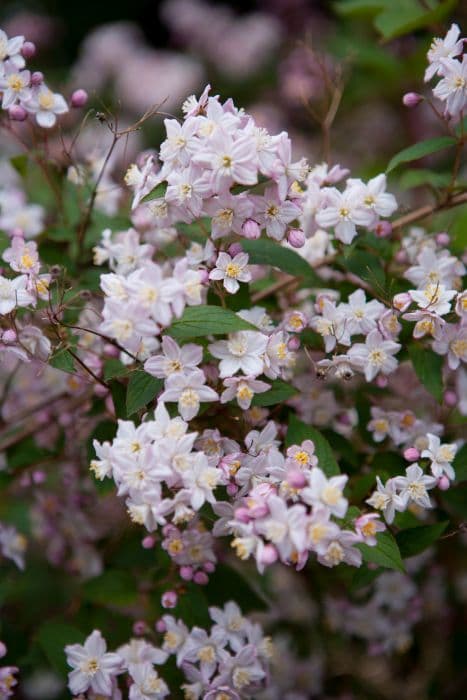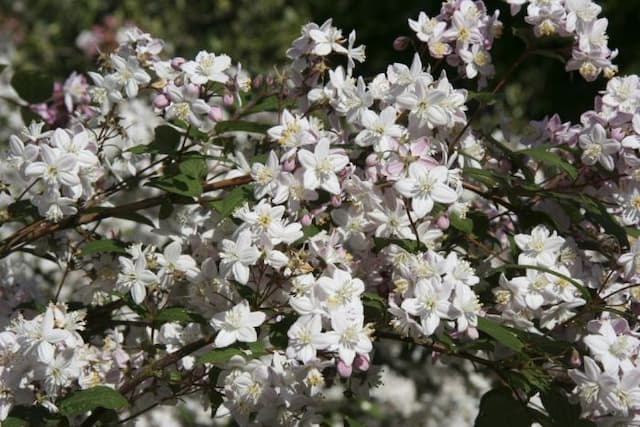Zebra Hydrangea Hydrangea macrophylla 'Zebra' (PBR) (Black Steel Series) (H)

ABOUT
Hydrangea macrophylla 'Zebra' is a striking ornamental shrub known for its distinctive blooms and stems. This plant boasts large, ball-shaped flower clusters that have a bright white color, which contrast dramatically with the plant's glossy, dark leaves. These vibrant flowers can sometimes take on a light pink or blue hue depending on the soil pH. The name 'Zebra' reflects this contrasting color palette. The striking aspect of this hydrangea variety is its stems, which exhibit a unique black coloration, giving it the 'Black Steel' series designation. This unusual stem color provides a strong visual backdrop to the lush foliage and radiant white blooms, contributing to the plant's bold and exotic appearance. The leaves themselves are broad and have a serrated edge, contributing to the rich texture of the plant. The overall impression of the Hydrangea macrophylla 'Zebra' is of a contrast between the dark, almost black stems and the brilliant white, globe-like flowers that bloom profusely during the flowering season. Its appearance is somewhat tropical and can add a dramatic flair to gardens or landscapes where it is a featured plant. Its visual appeal makes it a popular choice for those looking to create a focal point in their garden with something that has strong visual interest throughout the growing season.
About this plant
 Names
NamesFamily
Hydrangeaceae
Synonyms
Zebra Hydrangea, Black Steel Zebra Hydrangea
Common names
Hydrangea macrophylla 'Zebra'
 Toxicity
ToxicityTo humans
Hydrangeas, including Hydrangea macrophylla 'Zebra', contain compounds that can be toxic if ingested, such as cyanogenic glycosides. These compounds can release cyanide when chewed or digested, which is toxic. However, poisoning from hydrangeas is relatively rare in humans, as considerable amounts of plant material would need to be consumed to cause a severe reaction. Potential symptoms of hydrangea poisoning can include stomach upset, nausea, vomiting, and diarrhea. In more severe cases, symptoms might also include sweating, dizziness, and confusion due to the cyanide's effect on oxygen utilization within the body.
To pets
Hydrangeas, including Hydrangea macrophylla 'Zebra', are known to be toxic to pets such as cats, dogs, and horses. The plant contains cyanogenic glycosides, which can release cyanide in the animal's body when ingested. Signs of hydrangea poisoning in pets may include gastrointestinal upset, such as vomiting and diarrhea, which can occur relatively soon after ingestion. If a large enough amount of the plant is consumed, more serious symptoms could develop, such as depression, lethargy, abdominal pain, and in severe cases, cyanide intoxication can lead to more critical issues such as respiratory failure or even death. It is important to seek veterinary care if you suspect your pet has ingested hydrangea.
 Characteristics
CharacteristicsLife cycle
Perennials
Foliage type
Deciduous
Color of leaves
Green
Flower color
White
Height
4-5 feet (1.2-1.5 meters)
Spread
4 feet (1.2 meters)
Plant type
Shrub
Hardiness zones
5-9
Native area
Japan
Benefits
 General Benefits
General Benefits- Decorative blooms - Hydrangea macrophylla 'Zebra' features large, showy flowers that can add visual interest to any garden.
- Color changing flowers - The flower color may change depending on the soil pH, ranging from blue in acidic soils to pink in alkaline soils.
- Seasonal interest - It provides a long season of interest, blooming from early summer to late fall.
- Attracts pollinators - The flowers attract bees and other pollinators to the garden, which is beneficial for biodiversity.
- Shade tolerance - This plant can tolerate partial shade, making it suitable for a variety of garden locations.
- Easy to grow - Hydrangea macrophylla 'Zebra' is known for being easy to care for and maintain.
- Drought resistance - Once established, it can be relatively tolerant to dry conditions compared to other hydrangeas.
- Versatile landscaping - Suitable for borders, foundation plantings, and as a specimen plant.
- Pruning adaptability - It can be pruned to maintain desired size and shape or to promote a more robust bloom in the following season.
- Hardiness - It is fairly cold-resistant and can survive in temperatures down to USDA hardiness zones 5 through 9.
 Medical Properties
Medical PropertiesThis plant is not used for medical purposes.
 Air-purifying Qualities
Air-purifying QualitiesThis plant is not specifically known for air purifying qualities.
 Other Uses
Other Uses- Hydrangea blossoms can be dried and used to create long-lasting floral arrangements. Once dried, they maintain their shape and color for a significant time, and they can be used in wreaths, bouquets, or as standalone decorations.
- The intense blue and pink colors of Hydrangea flowers can be used as a natural pH indicator in educational settings. When placed in different pH solutions, the flower colors can change, demonstrating the acidic or alkaline nature of the solution.
- Hydrangea wood is dense and can be carved into small objects or jewelry. Artisans sometimes use the wood of older Hydrangea shrubs that have been pruned or removed to make decorative items or beads.
- Hydrangea leaves can be used in the production of a green dye. Although not a common practice, the leaves can yield a colorant for textiles when processed correctly.
- The striking pattern of the 'Zebra' Hydrangea can serve as inspiration for artists and designers. Its bold, contrasting flower colors and patterns are mimicked in various forms of art and design, including fabric prints and home décor.
- In some cultures, Hydrangeas are used in ceremonies and festivals. Their showy blooms can symbolize different meanings, such as heartfelt emotions or gratitude, and they're used in decorative displays or given as gifts during these events.
- Gardeners might propagate Hydrangea 'Zebra' for educational purposes, demonstrating techniques such as layering or softwood cuttings to amateur horticulturists or students learning about plant propagation.
- Photographers and nature enthusiasts may use Hydrangea 'Zebra' as a subject for macro photography, capturing the intricate details of the blooms and the contrast between the petals and dark stems.
- The dark steel stems of the 'Zebra' Hydrangea are distinctive and can be incorporated into sculpture or garden art. Creative gardeners can use these stems, whether fresh or dried, to add structure and contrast to their art pieces.
- During winter, when the blooms have faded, the skeletal remains of Hydrangea flower heads can be spray painted and used as part of Christmas decorations, offering a different texture and appearance to traditional festive adornment.
Interesting Facts
 Feng Shui
Feng ShuiThe Hydrangea is not used in Feng Shui practice.
 Zodiac Sign Compitability
Zodiac Sign CompitabilityThe Hydrangea is not used in astrology practice.
 Plant Symbolism
Plant Symbolism- Heartfelt Emotions: Hydrangeas, including the 'Zebra' variety, often symbolize deep and heartfelt emotions due to their full, round shape akin to a beating heart.
- Gratitude: Giving hydrangeas can be a way to express sincere gratitude, thanks to the lavish number of flowers and generous round shape of their blooms.
- Apology: In some contexts, hydrangeas may be used to offer apologies, as they can symbolize a desire for understanding and reconciliation.
- Vanity: Historically, hydrangeas have also been associated with vanity or boastfulness because of their showy and extensive clusters of flowers.
- Abundance: The lavish bloom of the hydrangea is frequently seen as a symbol of abundance and prosperity.
 Water
WaterThe Zebra Hydrangea should be watered deeply, ensuring that the soil is moist but not waterlogged. During the growing season, typically from spring through fall, water approximately 1 gallon per plant per week. Adjust frequency based on weather conditions; more water may be needed during particularly hot or dry spells and less during cooler, rainy periods. In winter, reduce watering but do not allow the soil to completely dry out. It is best to water in the morning to avoid excess moisture on leaves, which can lead to fungal diseases.
 Light
LightZebra Hydrangeas prefer partial shade with some morning sunlight and afternoon protection from the intense sun. A spot that receives dappled sunlight throughout the day is also suitable. Avoid placing them in deep shade or full, harsh sun to prevent stress and to maintain their vibrant blooms. An eastern-facing location where the plant is shielded from the strong late day sun is ideal.
 Temperature
TemperatureZebra Hydrangeas thrive in temperatures between 65°F and 75°F, which they typically experience in spring and fall. They can tolerate a minimum temperature of around 50°F, but frost can damage the plant and flowers. The maximum temperature for these Hydrangeas is around 80°F; temperatures above this may stress the plant and require additional shade and water.
 Pruning
PruningZebra Hydrangeas benefit from pruning to encourage vigorous growth and maintain shape. Prune in late winter or early spring before new growth starts. Remove dead or weak stems and cut back about one-third of the oldest stems to ground level to encourage new, healthy shoots. The best time to prune is after the threat of the harshest winter weather has passed but before new spring growth begins.
 Cleaning
CleaningAs needed
 Soil
SoilHydrangeas prefer moist, well-draining soil rich in organic matter, with a pH that influences flower color. For Hydrangea macrophylla 'Zebra', a soil mix with peat, compost, and perlite would be ideal. Aim for a slightly acidic to neutral pH of 5.5 to 7.0; this pH supports robust growth and healthy blooms.
 Repotting
Repotting'Zebra' Hydrangea should be repotted every 2 to 3 years, or when the plant outgrows its current pot. Spring is the best time for repotting to minimize stress on the plant.
 Humidity & Misting
Humidity & MistingHydrangeas thrive in environments with high humidity, around 60-70%. To provide the best care for Hydrangea macrophylla 'Zebra', maintain these humidity levels, especially when growing the plant indoors.
 Suitable locations
Suitable locationsIndoor
Provide bright, indirect light and keep soil moist.
Outdoor
Plant in partial shade, sheltered from strong winds.
Hardiness zone
5-9 USDA
 Life cycle
Life cycleThe Hydrangea macrophylla 'Zebra', also known as the Zebra Hydrangea, begins its life cycle with germination, which occurs when its seeds are sown in well-draining soil with adequate moisture, typically in the spring. Following germination, the seedling stage involves the development of roots and shoots, which then mature into a young plant with distinctive foliage. As the Zebra Hydrangea enters the vegetative stage, it produces lush green leaves with a striking black stem, indicating its inclusion in the Black Steel Series. During the flowering stage, usually in early summer, it produces large, white, mophead flowers that contrast beautifully against the dark stems, and this blooming can last until fall under optimal conditions. After the blooming period, the plant goes into a dormancy stage in the winter, where it conserves energy and may lose leaves depending on the climate. Finally, it completes its cycle by either producing seeds that can disperse to create new plants or through vegetative propagation where new shoots can grow from the root system or stem cuttings in the following growing season.
 Propogation
PropogationPropogation time
Spring to Early Summer
Propogation: The most popular method of propagation for the Hydrangea macrophylla 'Zebra' is softwood cuttings. This method typically takes place in late spring to early summer, when new growth is still tender but mature enough to handle cutting. To propagate, you would take a cutting of about 4 to 6 inches long with several leaves, dipping the cut end into rooting hormone to encourage root development. The cutting should then be planted in a well-draining soil mix, keeping it moist and covered with a plastic bag or dome to maintain high humidity levels. It usually takes a few weeks for roots to establish, after which you can gradually acclimate the new hydrangea plantlets to normal conditions before planting them out.








![Hydrangea [Early Sensation]](/_next/image?url=https%3A%2F%2Fplants-admin.emdemapps.com%2Fimages%2Fplants%2F%2Fimages%2F604b6150338db.png&w=640&q=75)
